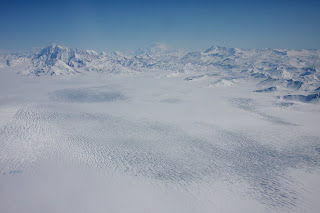We came here to drill through the ice shelf at Pine Island Glacier. This is one of most rapidly changing glaciers on the planet and it is a big one. Much of the changes can be blamed on warm ocean water that is getting under a floating ice shelf and is melting it from below. We are planning to drill through it and then measure that process directly.
Getting out to PIG is not easy. The distance from McMurdo to the base camp exceeds 1500 miles (~2500 km). It is comparable to the distance from Seattle to Chicago (or Madrid to Oslo for the more European declined). Imagine moving a field party, a hot water drill and a lot of instrumentation across the coldest and windiest continent. Delays are inevitable, and bad weather, mechanical failures, and simply bad luck have all played a role.
Instead we are enjoying McMurdo. As much as I'd like to get out of here; it is an interesting town to explore. Its summer population is about 1,000 people. It could be like any small town in the Arctic, but one pretty quickly realizes that it's not the same. There are no kids, no elders, and no dogs. The town is entirely dedicated to supporting science and to a large degree to supporting the South Pole station.
 The view above is from Observation Hill, a small volcanic cone above town. The small peninsula in the background is where Captain Scott set up winter quarters, just over 100 years ago. The hut can be seen in the picture below.
The view above is from Observation Hill, a small volcanic cone above town. The small peninsula in the background is where Captain Scott set up winter quarters, just over 100 years ago. The hut can be seen in the picture below. His bid for the South Pole ended tragically, and Scott and his men died on the way back from the pole, after having been beaten to the goal by the Norwegian explorer Amundson, who had already successfully completed the first navigation of the Northwest Passage in the Arctic (at least the first European navigation...). The 100 year anniversary of his arrival at the South Pole was commemorated last week. The Norwegian prime minister flew in for the occasion.
His bid for the South Pole ended tragically, and Scott and his men died on the way back from the pole, after having been beaten to the goal by the Norwegian explorer Amundson, who had already successfully completed the first navigation of the Northwest Passage in the Arctic (at least the first European navigation...). The 100 year anniversary of his arrival at the South Pole was commemorated last week. The Norwegian prime minister flew in for the occasion.Scott's misfortunes are commemorated with a cross on Observation Hill. It was put up by surviving members who waited for his return in 1913.
 McMurdo can be a nice place in beautiful weather. The mountain range across the sound (the Royal Society Range) is beautiful and beckons, but, alas, no heliskiing for us...
McMurdo can be a nice place in beautiful weather. The mountain range across the sound (the Royal Society Range) is beautiful and beckons, but, alas, no heliskiing for us... On the other side we are greeted by Mt. Erebus, one of Earth's most active volcanoes, and its southernmost. It always has a little puff cloud. Another set of nice looking slopes, but, again, off limits.
On the other side we are greeted by Mt. Erebus, one of Earth's most active volcanoes, and its southernmost. It always has a little puff cloud. Another set of nice looking slopes, but, again, off limits. McMurdo is, of course, entirely dependent on outside support. This happens via ship (once a year) and via several airplanes during the Antarctic summer. Everything that was used gets shipped off the continent again and goes back to the US for proper disposal. In the process, there is a relatively elaborate waste separation program. Occasionally, somebody with a sense of humor enhances that program (see the one in the middle):
McMurdo is, of course, entirely dependent on outside support. This happens via ship (once a year) and via several airplanes during the Antarctic summer. Everything that was used gets shipped off the continent again and goes back to the US for proper disposal. In the process, there is a relatively elaborate waste separation program. Occasionally, somebody with a sense of humor enhances that program (see the one in the middle): Under the cover of each recycling bin, one can find detailed instructions about what can and cannot be disposed of here:
Under the cover of each recycling bin, one can find detailed instructions about what can and cannot be disposed of here: One of the big challenges of McMurdo is energy. It is cold here and windy. Not so bad in the summer, right now temperatures are always around, but mostly above freezing. Almost the entire station runs on diesel that is shipped here. For the past two years, three wind turbines are operational. These mostly supply the neighboring Scott Station, which is operated by New Zealand, but some excess power comes to McMurdo.
One of the big challenges of McMurdo is energy. It is cold here and windy. Not so bad in the summer, right now temperatures are always around, but mostly above freezing. Almost the entire station runs on diesel that is shipped here. For the past two years, three wind turbines are operational. These mostly supply the neighboring Scott Station, which is operated by New Zealand, but some excess power comes to McMurdo. Scott Station:
Scott Station: And to finish of: A picture of our team member Dale Pomraning (hot water driller) doing some indoor crevasse rescue training.
And to finish of: A picture of our team member Dale Pomraning (hot water driller) doing some indoor crevasse rescue training.




































